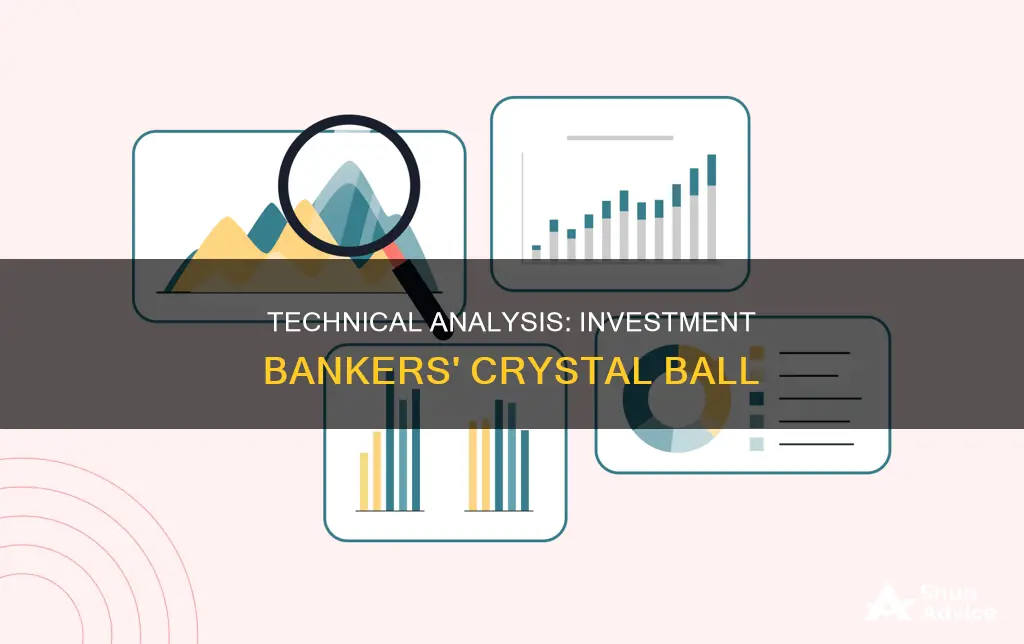
Investment bankers use technical analysis to predict future stock behaviour by identifying patterns in historical price and volume data. It is a method of evaluating statistical trends in trading activity, typically involving price movement and volume. Technical analysis is used to evaluate price trends and patterns and identify potential investments and trading opportunities. It is based on the assumption that past trading activity and a security's price changes can be valuable indicators of future price movements. Investment banks have dedicated trading teams that use technical analysis to advise and guide their clients.
What You'll Learn

Technical analysis vs fundamental analysis
Investment bankers and other traders use technical analysis to identify trading and investment opportunities. It is one of two main schools of thought when it comes to evaluating investments and making trading decisions, the other being fundamental analysis. While both approaches aim to predict future price movements and identify profitable opportunities, they take very different paths.
Fundamental Analysis
Fundamental analysis attempts to determine the intrinsic value of a security, sector, or economy by examining economic and financial factors. It involves diving deep into a company's financial statements, industry trends, economic indicators, and qualitative factors like the quality of the firm's management and competitive advantages. Fundamental analysts believe that by understanding a business's underlying health and potential, they can identify undervalued assets poised for growth. This approach is generally used for those looking for long-term value.
Technical Analysis
Technical analysis, on the other hand, bypasses the underlying company's fundamentals and instead focuses on statistical trends, price movements, and chart patterns. Technical analysts, sometimes called chartists, use various indicators to predict future price movements based on the premise that historical prices indicate market psychology that can predict trends. This approach is often used for shorter-term trades or to identify entry prices on stocks where fundamental analysis has already been performed.
Key Differences
The key differences between fundamental and technical analysis lie in the time horizon, the data used, and the focus of the analysis. Fundamental analysis typically focuses on long-term returns and uses a wide range of data sources, including financial statements, economic indicators, news and events, and qualitative information. In contrast, technical analysis focuses on optimising short-term trades by analysing historical price movements and volume data.
Pros and Cons
Both fundamental and technical analysis have their strengths and weaknesses. Fundamental analysis provides a comprehensive understanding of a company's financial health and is useful for long-term investment strategies. However, it can be time-consuming and may not capture short-term market trends and investor psychology. Technical analysis, on the other hand, offers a quick, visual way to evaluate assets and identify entry and exit points. However, it has been criticised for being unreliable and based solely on historical data, without considering the underlying financial health of the asset.
Combining the Two Approaches
In practice, many investors combine aspects of both fundamental and technical analyses to inform their decisions. By blending the two approaches, investors can leverage the strengths of each to compensate for their weaknesses. For example, an investor might first use fundamental analysis to gauge the intrinsic value of an asset and then apply technical analysis to identify the best entry and exit points. This blended approach can provide a more complete understanding of an asset or market and is suitable for both short- and long-term investment strategies.
Understanding Cash Flows from Ordinary Investing Activities
You may want to see also

How to identify trends
Technical analysis is a tool used to predict the future price movement of a security, such as a stock or currency pair, based on market data. It is based on the notion that the collective actions—buying and selling—of all market participants reflect all relevant information pertaining to a traded security, thus assigning it a fair market value.
To identify trends, technical analysts use price charts to predict price movement. The two primary variables for technical analysis are the time frames considered and the specific technical indicators employed. Time frames can range from one-minute to monthly or even yearly spans, with popular choices including 5-minute, 15-minute, hourly, 4-hour, daily, and weekly charts. Intra-day traders tend to favour shorter time frames, while long-term traders opt for longer ones.
Candlestick charting is the most common method for depicting price movement. A candlestick represents the price action during a single time period, with the highest and lowest points indicating the highest and lowest prices, respectively. The "body" of the candlestick reflects the opening and closing prices, with the colour indicating whether the closing price was higher or lower. These candlesticks can form patterns, such as the "doji", which indicate indecision in the market and a potential impending trend change.
Moving averages are another widely used technical indicator. A simple moving average strategy might involve buying when the price remains above a certain exponential moving average and selling when it falls below. Moving average crossovers, where a shorter-term moving average crosses a longer-term one, are also monitored.
Fibonacci levels, based on ratios developed by the 12th-century mathematician Fibonacci, are used to pinpoint trading opportunities and entry and exit points during sustained trends.
Momentum indicators, such as the Stochastic Oscillator, Relative Strength Index (RSI), Moving Average Convergence-Divergence (MACD), and Average Directional Movement Index (ADX), help determine market strength and identify early warnings of trend endings.
In summary, technical analysts employ a variety of tools and indicators, including candlestick patterns, moving averages, Fibonacci levels, and momentum indicators, to identify trends and make informed trading decisions.
Discount Cash Flow Analysis: Investment Bankers' Go-To Tool
You may want to see also

Using charting tools
Investment bankers use charting tools to identify patterns and trends in a stock or security's previous performance to predict its future behaviour. This involves analysing price and volume data, which is typically reflected in the form of charts.
There are several indicators that analysts look for when using charting tools. These include:
- Patterns: Any distinctive or clear pattern the stock chart shows.
- Cycles: A period of time that a price trends in one direction, after which it changes course.
- Resistance: Price levels that could lead to a large increase in the selling of a stock.
- Support: Price levels that could lead to a large increase in the buying of a stock.
Charting tools are used to generate short-term trading signals and help evaluate a security's strength or weakness relative to the broader market or one of its sectors. This, in turn, helps analysts improve their overall valuation estimates.
While some critics of technical analysis claim that it is a scam or a superficial study of charts and patterns without any concrete results, it is a common practice used by investment banks to inform their trading and investment decisions.
Target's Overseas Strategy: Direct Investment Approach?
You may want to see also

The limitations of technical analysis
Technical analysis is a method of evaluating statistical trends in trading activity, typically involving price movement and volume. It is used by investment bankers to identify trading and investment opportunities. However, it has its limitations.
Firstly, some analysts and academic researchers believe that the Efficient Markets Hypothesis (EMH) demonstrates that no actionable information is contained in historical price and volume data. They argue that historical price patterns do not repeat themselves exactly, and therefore, price pattern study is of limited importance.
Secondly, technical analysis has been criticised for only working in some cases because it constitutes a self-fulfilling prophecy. For example, if a large number of traders place a stop-loss order below a company's 200-day moving average, there will be a high volume of sell orders if the stock reaches this price, pushing the stock price down. This short-term selling pressure reinforces the strength of the downward trend. However, this group of traders cannot drive the price over the long term.
Thirdly, technical analysis is often denounced as a superficial study of charts and patterns without any concrete, conclusive, or profitable results. It is seen as a short-term trading strategy that does not provide insights into a company's intrinsic value or long-term prospects.
Finally, technical analysis is not a guaranteed way to make precise price predictions and should not be expected to be equally appropriate across all financial markets. It is a tool that provides a predictive range and helps identify potential trading opportunities, but it does not provide a 100% accuracy rate.
In conclusion, while technical analysis can be a valuable tool for investment bankers, it has limitations and should be used alongside other methods such as fundamental analysis to make more informed trading decisions.
Owner's Investment Cash: Operating Activity?
You may want to see also

How technical analysis is used in forex trading
Technical analysis is a method used by investment bankers to evaluate statistical trends in trading activity, with a focus on price and volume to make predictions about future price movements. It is used in forex trading to identify trading opportunities and inform decision-making.
Technical analysis is a valuable tool for forex traders as it helps them identify trading opportunities and make informed decisions about their trades. By analysing historical price movements and patterns, traders can determine the future direction of a market, as well as possible entry and exit points for each position. This is based on the assumption that market prices reflect all publicly available information, making historical data a reliable indicator of future price movements.
Forex traders use charts and technical indicators to identify support and resistance levels, trends, and ranges in the market. They look for patterns such as wedges, triangles, channels, double tops and bottoms, and head and shoulders formations. Additionally, they employ quantitative techniques like moving averages, Bollinger Bands®, and Fibonacci retracements, as well as analysis of oscillators and momentum indicators like MACD, RSI, and stochastics.
One of the key advantages of technical analysis in forex trading is its neutrality. It can be applied to any currency pair over any timeframe, providing traders with a consistent framework for analysing the market. Technical analysis also allows traders to combine it with other forms of analysis, such as fundamental analysis, to develop a more comprehensive understanding of the market and make more informed trading decisions.
However, it is important to note that technical analysis has its limitations. It relies solely on historical price data, assuming that past patterns will repeat themselves. This assumption may not always hold true, as external factors or unpredictable events can influence the market in unexpected ways. Therefore, it is crucial for traders to complement technical analysis with other forms of research and risk management strategies to make more robust trading decisions.
Health Insurers: Relationship-Specific Investments for Tailored Benefits
You may want to see also
Frequently asked questions
Technical analysis is a method of evaluating statistical trends in trading activity, typically involving price movement and volume. It is used to identify trading and investment opportunities.
Technical analysis uses a stock or security’s previous performance to identify trends and patterns and determine how it will behave in the future. This type of analysis can be done on any security that is traded and has historical data available.
Investment bankers use technical analysis to look at market trends to advise and guide their clients. They use charting tools to generate short-term trading signals and to evaluate a security's strength or weakness relative to the broader market.
Some analysts and academic researchers argue that historical price and volume data do not contain any actionable information. Technical analysis also assumes that the market reflects any and all macroeconomic changes and trends, which may not always be the case.







